NVIDIA’s GeForce GTX Titan Review, Part 2: Titan's Performance Unveiled
by Ryan Smith & Rahul Garg on February 21, 2013 9:00 AM ESTTitan’s Compute Performance (aka Ph.D Lust)
Because GK110 is such a unique GPU from NVIDIA when it comes to compute, we’re going to shake things up a bit and take a look at compute performance first before jumping into our look at gaming performance.
On a personal note, one of the great things about working at AnandTech is all the people you get to work with. Anand himself is nothing short of fantastic, but what other review site also has a Brian Klug or a Jarred Walton? We have experts in a number of fields, and as a computer technology site that includes of course includes experts in computer science.
What I’m trying to say is that for the last week I’ve been having to fend off our CS guys, who upon hearing I had a GK110 card wanted one of their own. If you’ve ever wanted proof of just how big a deal GK110 is – and by extension Titan – you really don’t have to look too much farther than that.
Titan, its compute performance, and the possibilities it unlocks is a very big deal for researchers and other professionals that need every last drop of compute performance that they can get, for as cheap as they can get it. This is why on the compute front Titan stands alone; in NVIDIA’s consumer product lineup there’s nothing like it, and even AMD’s Tahiti based cards (7970, etc), while potent, are very different from GK110/Kepler in a number of ways. Titan essentially writes its own ticket here.
In any case, as this is the first GK110 product that we have had access to, we couldn’t help but run it through a battery of tests. The Tesla K20 series may have been out for a couple of months now, but at $3500 for the base K20 card, Titan is the first GK110 card many compute junkies are going to have real access to.
To that end I'd like to introduce our newest writer, Rahul Garg, who will be leading our look at Titan/GK110’s compute performance. Rahul is a Ph.D student specializing in the field of parallel computing and GPGPU technology, making him a prime candidate for taking a critical but nuanced look at what GK110 can do. You will be seeing more of Rahul in the future, but first and foremost he has a 7.1B transistor GPU to analyze. So let’s dive right in.
By: Rahul Garg
For compute performance, we first looked at two common benchmarks: GEMM (measures performance of dense matrix multiplication) and FFT (Fast Fourier Transform). These numerical operations are important in a variety of scientific fields. GEMM is highly parallel and typically compute heavy, and one of the first tests of performance and efficiency on any parallel architecture geared towards HPC workloads. FFT is typically memory bandwidth bound but, depending upon the architecture, can be influenced by inter-core communication bandwidth. Vendors and third-parties typically supply optimized libraries for these operations. For example, Intel supplies MKL for Intel processors (including Xeon Phi) and AMD supplies ACML and OpenCL-based libraries for their CPUs and GPUs respectively. Thus, these benchmarks measure the performance of the combination of both the hardware and software stack.
For GEMM, we tested the performance of NVIDIA's CUBLAS library supplied with CUDA SDK 5.0, on SGEMM (single-precision/fp32 GEMM) and DGEMM (double precision/fp64 GEMM) on square matrices of size 5k by 5k. For SGEMM on Titan, the data reported here was collected with boost disabled. We also conducted the experiments with boost enabled on Titan, but found that the performance was effectively equal to the non-boost case. We assume that it is because our test ran for a very short period of time and perhaps did not trigger boost. Therefore, for the sake of simpler analysis, we report the data with boost disabled on the Titan. If time permits, we may return to the boost issue in a future article for this benchmark.
Apart from the results collected by us for GTX Titan, GTX 680 and GTX 580, we refer to experiments conducted by Matsumoto, Nakasato and Sedukin reported in a technical report filed at the University of Aizu about GEMM on Radeon 7970. Their exact parameters and testbed are different than ours, and we include their results for illustrative purposes, as a ballpark estimate only. The results are below.
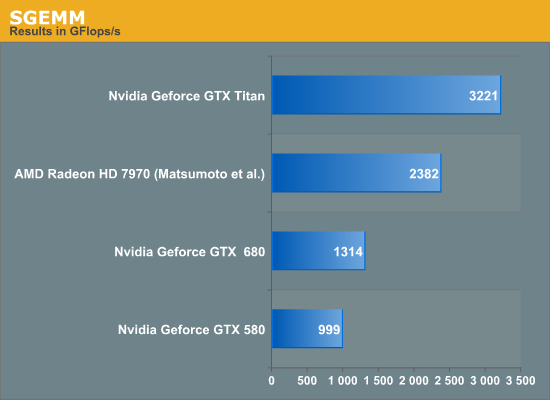
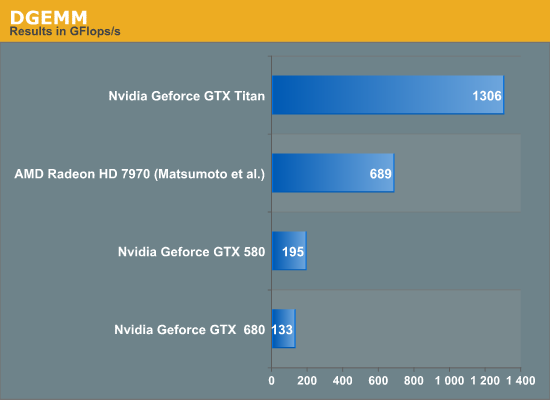
Titan rules the roost amongst the three listed cards in both SGEMM and DGEMM by a wide margin. We have not included Intel's Xeon Phi in this test, but the TItan's achieved performance is higher than the theoretical peak FLOPS of the current crop of Xeon Phi. Sharp-eyed readers will have observed that the Titan achieves about 1.3 teraflops on DGEMM, while the listed fp64 theoretical peak is also 1.3 TFlops; we were not expecting 100% of peak on the Titan in DGEMM. NVIDIA clarified that the fp64 rating for the Titan is a conservative estimate. At 837MHz, the calculated fp64 peak of Titan is 1.5 TFlops. However, under heavy load in fp64 mode, the card may underclock below the listed 837MHz to remain within the power and thermal specifications. Thus, fp64 ALU peak can vary between 1.3 TFlops and 1.5 TFlops and our DGEMM results are within expectations.
Next, we consider the percentage of fp32 peak achieved by the respective SGEMM implementations. These are plotted below.
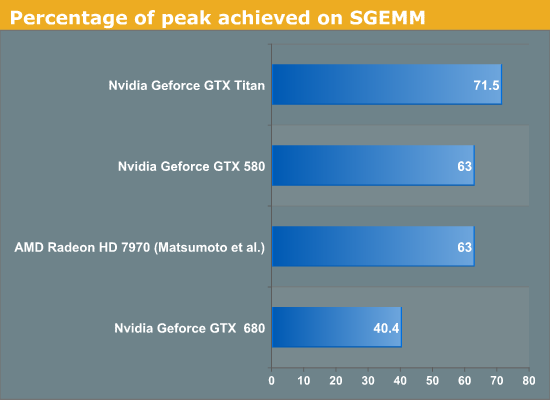
Titan achieves about 71% of its peak while GTX 680 only achieves about 40% of the peak. It is clear that while both GTX 680 and Titan are said to be Kepler architecture chips, Titan is not just a bigger GTX 680. Architectural tweaks have been made that enable it to reach much higher efficiency than the GTX 680 on at least some compute workloads. GCN based Radeon 7970 obtains about 63% of peak on SGEMM using Matsumoto et al. algorithm, and Fermi based GTX 580 also obtains about 63% of peak using CUBLAS.
For FFT, we tested the performance of 1D complex-to-complex inplace transforms of size 225 using the CUFFT library. Results are given below.
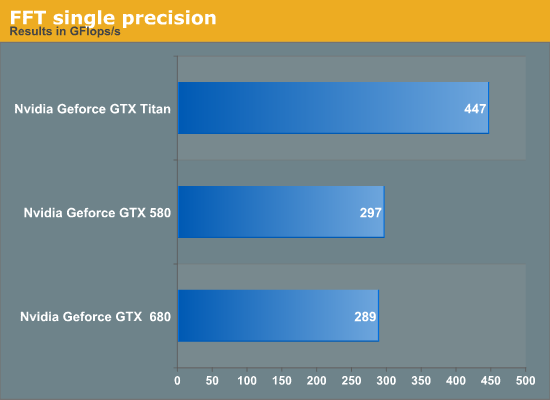
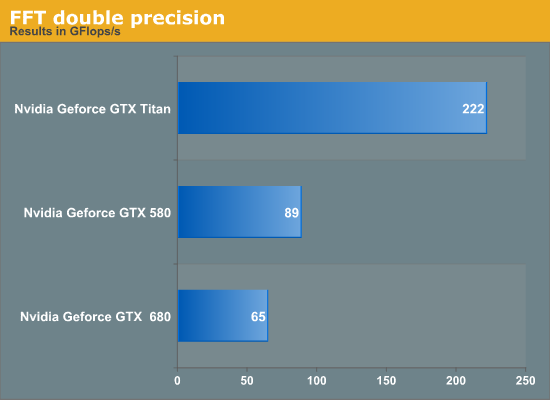
Titan outperforms the GTX 680 in FFT by about 50% in single-precision. We suspect this is primarily due to increased memory bandwidth on Titan compared to GTX 680 but we have not verified this hypothesis. GTX 580 has a slight lead over the GTX 680. Again, if time permits, we may return to the benchmark for a deeper analysis. Titan achieves about 3.4x the performance of GTX 680 but this is not surprising given the poor fp64 execution resources on the GTX 680.
We then looked at an in-house benchmark called SystemCompute, developed by our own Ian Cutress. The benchmark tests the performance on a variety of sample kernels that are representative of some scientific computing applications. Ian described the CPU version of these benchmarks in a previous article. Ian wrote the GPU version of the benchmarks in C++ AMP, which is a relatively new GPGPU API introduced by Microsoft in VS2012.
Microsoft's implementation of AMP compiles down to DirectCompute shaders. These are all single-precision benchmarks and should run on any DX11 capable GPU. The benchmarks include 2D and 3D finite difference solvers, 3d particle movement, n-body benchmark and a simple matrix multiplication algorithm. Boost is enabled on both the Titan and GTX 680 for this benchmark. We give the score reported by the benchmark for both cards, and report the speedup of the Titan over 680. Speedup greater than 1 implies Titan is faster, while less than 1 implies a slowdown.
| Benchmark | GTX 580 | GTX 680 | GTX Titan |
Speedup of Titan over GTX 680 |
| 2D FD | 9053 | 8445 | 12461 | 1.47 |
| 3D FD | 3133 | 3827 | 5263 | 1.37 |
| 3DPmo | 41722 | 26955 | 40397 | 1.49 |
| MatMul | 172 | 197 | 229 | 1.16 |
| nbody | 918 | 1517 | 2418 | 1.59 |
The benchmarks show between 16% and 60% improvement, with the most improvement coming from the relatively FLOP-heavy n-body benchmark. Interestingly, GTX 580 wins over the Titan in 3DPMo and wins over the 680 in 3DPmo and 2D.
Overall, GTX Titan is an impressive accelerator from compute perspective and posts large gains over its predecessors.










337 Comments
View All Comments
vps - Thursday, February 21, 2013 - link
For compute benchmark you might want to take a look at FAHBenchFAHBench is the official Folding@Home GPU benchmark. It measures the compute performance of GPUs for Folding@Home.
http://proteneer.com/blog/?page_id=1671
Some reference scores are here:
http://foldingforum.org/viewtopic.php?f=38&t=2...
Ryan Smith - Thursday, February 21, 2013 - link
FAHBench is primarily an OpenCL benchmark (there's a CUDA path, but it's effectively on its way out). It's on our list, and is one of the things we couldn't run due to the fact that OpenCL is not currently working on Titan.Hrel - Thursday, February 21, 2013 - link
PowerDirector still uses CUDAatlr - Thursday, February 21, 2013 - link
Not sure if this helps. I found CLBenchmark results of a Titan versus a 7970 here.http://clbenchmark.com/compare.jsp?config_0=144702...
atlr - Thursday, February 21, 2013 - link
Ville Timonen posted results running his own code on a Tesla K20 versus the usual suspects. Might be helpful to folks considering options for GPGPU computation.http://wili.cc/blog/gpgpu-faceoff.html
chizow - Thursday, February 21, 2013 - link
That's the first thing that comes to mind now when I think of Nvidia, which is a shame because that name used to be synonymous with Awesome. That's gone and replaced with a disdain for ridiculous levels of usury with their last two high-end product launches. I'm not going to be disingenuous and claim I'm going AMD, because the fact of the matter is, Nvidia products are still in a class of it's own for my usage needs, but I will certainly not be spending as much on Nvidia parts as I used to.Kepler has basically set back Nvidia's product stack back by half a generation, but my price:performance metrics will stay the same. Nvidia has their ultra-premium "Xtreme Edition" GPU this round, but that only came about as a result of AMD's ridiculous pricing and overall lackluster performance of the 7970 for a "flagship" card. Either way, I think it will be difficult for Nvidia to sustain this price point, as expectations just got higher at that $1K range.
@Ryan: I'm disappointed you didn't write a harsher commentary on the fact Nvidia is now charging 2x for the same class of GPU, pricing that has stayed true since 2006. Even the G80 Ultra didn't approach this $1K mark. Given how many times Nvidia has had to backpedal and apologize about the Ultra's pricing, you would think they would learn from their mistakes. I guess not, I hope they are prepared to deal with the long-term ramifications, backlash, and loss of goodwill stemming from this pricing decision.
CeriseCogburn - Thursday, February 21, 2013 - link
7.1 billion transistors and 6G of ram.I for one am sick of you people constantly whining.
If we check the whine log from the ATI32 days you were doing it then, too.
It's all you people do. Every time, all the time.
chizow - Friday, February 22, 2013 - link
And all you do is post inane, barely intelligible nonsense in defense of Nvidia. If you check your "whine logs" you'll see I've done my fair share of defending Nvidia, but I can't and won't give them a pass for what they've done with Kepler. AMD started it for sure with the terribad price:performance of Tahiti, but Nvidia has taken it to a new level of greed.And for all the idiots who are going to reply "herr dueerr Nvidai need make money not a charity derrr", my advanced reply is that Nvidia has made money in all but 2-3 quarters since 2006 without selling a single $1K desktop GPU. In fact, they enjoyed record profits, margin and revenue on the back of a $250 GPU, the 8800GT in 2007-2008.
CeriseCogburn - Saturday, February 23, 2013 - link
Nope, you are the crying whining baby who says the same thing in 100 different posts here, and has no clue what "the economy" of "the world" has been doing for the past several years.Whatever.
Please go cry about all the other computer part prices that are doing the same thing.
CeriseCogburn - Saturday, February 23, 2013 - link
I mean you idiots want the same price for more perf over a DECADE. Meanwhile, the rest of the worlds pricing has DOUBLED.Now, computer prices used to drop across the board, but they just aren't doing it anymore, and IDIOTS like yourself continue on your stupid frikkin rants, ignoring the world itself, not to mention the LACK of production in that world for the GPU's you whine about. It's really funny how stupid you are.